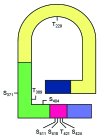p70 S6 kinase and actin dynamics: A perspective
- PMID: 22553489
- PMCID: PMC3341245
- DOI: 10.4161/spmg.19413
p70 S6 kinase and actin dynamics: A perspective
Abstract
p70 S6 kinase (p70(S6K)), a member of the AGC serine/threonine kinase family, was initially identified as a key player, together with its downstream effector S6, in the regulation of cellular growth and survival. The p70(S6K) protein has emerged in recent years as a multifunctional protein which also regulates the actin cytoskeleton and thus plays a role in cell migration. This new function is through two important activities of p70(S6K), namely actin cross-linking and Rac1 and Cdc42 activation. The testis is critically dependent on an intricate balance of fundamental cellular processes such as adhesion, migration, and differentiation. It is increasingly evident that Rho GTPases and actin binding proteins play fundamental roles in regulating spermatogenesis within the testis. In this review, we will discuss current findings of p70(S6K) in the control of actin cytoskeleton dynamics. In addition, the potential role of p70(S6K) in spermatogenesis and testicular function will be highlighted.
Figures



Similar articles
-
p70 S6 kinase in the control of actin cytoskeleton dynamics and directed migration of ovarian cancer cells.Oncogene. 2011 May 26;30(21):2420-32. doi: 10.1038/onc.2010.615. Epub 2011 Jan 24. Oncogene. 2011. PMID: 21258406
-
Role of the p70(S6K) pathway in regulating the actin cytoskeleton and cell migration.Exp Cell Res. 2004 Jun 10;296(2):183-95. doi: 10.1016/j.yexcr.2003.12.032. Exp Cell Res. 2004. PMID: 15149849
-
Role of MLK3-mediated activation of p70 S6 kinase in Rac1 transformation.J Biol Chem. 2002 Feb 15;277(7):4770-7. doi: 10.1074/jbc.M109379200. Epub 2001 Nov 16. J Biol Chem. 2002. PMID: 11713255
-
[Research progress of p70 ribosomal protein S6 kinase inhibitors].Yao Xue Xue Bao. 2015 Mar;50(3):261-71. Yao Xue Xue Bao. 2015. PMID: 26118103 Review. Chinese.
-
TOR action in mammalian cells and in Caenorhabditis elegans.Curr Top Microbiol Immunol. 2004;279:115-38. doi: 10.1007/978-3-642-18930-2_8. Curr Top Microbiol Immunol. 2004. PMID: 14560955 Review.
Cited by
-
Role of mTOR downstream effector signaling molecules in Francisella tularensis internalization by murine macrophages.PLoS One. 2013 Dec 3;8(12):e83226. doi: 10.1371/journal.pone.0083226. eCollection 2013. PLoS One. 2013. PMID: 24312679 Free PMC article.
-
Targeting the PI3K/AKT/mTOR Signaling Pathway in Lung Cancer: An Update Regarding Potential Drugs and Natural Products.Molecules. 2021 Jul 5;26(13):4100. doi: 10.3390/molecules26134100. Molecules. 2021. PMID: 34279440 Free PMC article. Review.
-
Erianthridin suppresses non-small-cell lung cancer cell metastasis through inhibition of Akt/mTOR/p70S6K signaling pathway.Sci Rep. 2021 Mar 23;11(1):6618. doi: 10.1038/s41598-021-85675-8. Sci Rep. 2021. PMID: 33758209 Free PMC article.
-
Characterization of non-olfactory GPCRs in human sperm with a focus on GPR18.Sci Rep. 2016 Aug 30;6:32255. doi: 10.1038/srep32255. Sci Rep. 2016. PMID: 27572937 Free PMC article.
-
mTOR Signaling Pathway Regulates Sperm Quality in Older Men.Cells. 2019 Jun 21;8(6):629. doi: 10.3390/cells8060629. Cells. 2019. PMID: 31234465 Free PMC article.
References
-
- Winter GD. Movement of epidermal cells over the wound surface. In: Montagna W, Billingham RE, eds. Advances in Biology of Skin - Vol V, Wound Healing. Oxford: Pergamon Press, 1964:133-27.
LinkOut - more resources
Full Text Sources
Research Materials
Miscellaneous
